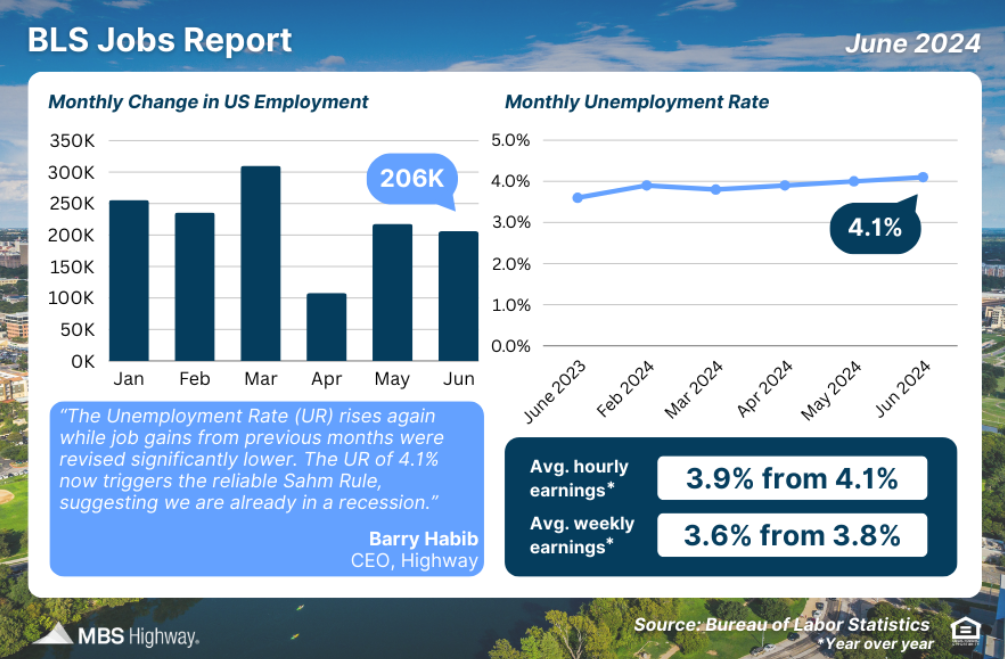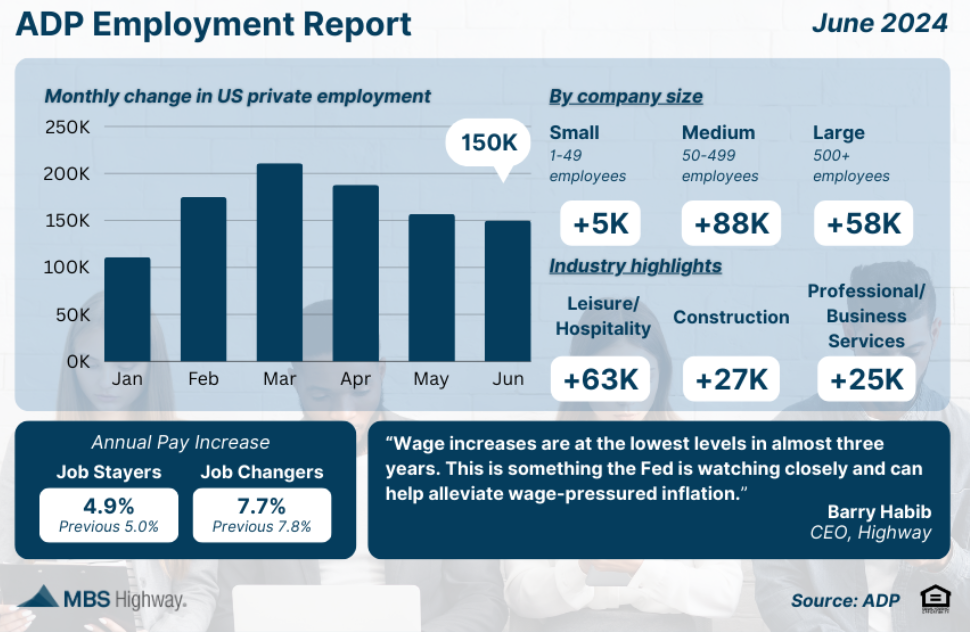Week of July 1, 2024 in Review
There are more signs that the labor sector is softening, as job growth eased in June and the uptick in the Unemployment Rate triggered an important recession indicator. Meanwhile, home prices continue to rise nationwide. Here are last week’s headlines:
- Sahm-thing Happening in the Labor Sector
- Private Payrolls, Annual Wage Gains Slow
- Job Openings Remain Near 3-Year Lows
- Jobless Claims Trending Higher
- Strong Spring for Home Prices
Sahm-thing Happening in the Labor Sector
The Bureau of Labor Statistics (BLS) reported that there were 206,000 jobs created in June, which was just above estimates of 200,000 new jobs. However, there were big negative revisions to April and May, which shaved 111,000 jobs from those months combined. The unemployment rate rose from 4% to 4.1%.

What’s the bottom line? While the headline job growth figure beat estimates, future revisions lower are a very real possibility, given that we continue to see this pattern from the BLS. Plus, it’s important to look at both surveys within the Jobs Report, which told two different stories regarding job growth. The headline job number (+206,000) comes from the report’s Business Survey, which is based predominantly on modeling and estimations. However, the Household Survey’s job creation component (which is considered more real-time because it’s derived by calling households) showed only 116,000 job gains, much lower than the headline number. Plus, the data showed we continue to lose full-time jobs while gaining part-time workers, which is a theme we’ve seen for quite some time.
The Unemployment Rate also rose from 4% to 4.1%, the highest level since November 2021. This increase triggered the Sahm Rule, which portends a recession with a high degree of certainty. Named after former Fed economist Claudia Sahm, this recession indicator flashes when the three-month moving average of the unemployment rate rises by 0.5% or more relative to its low during the previous 12 months.
Private Payrolls, Annual Wage Gains Slow
ADP’s Employment Report showed that private payrolls rose less than expected in June, as employers added 150,000 new jobs versus the 160,000 that had been forecasted. This marks the third straight month that job creation has slowed among private employers. Nearly all the gains came from service-providing sectors (+136,000), with goods producers only adding 14,000 jobs due to a slowdown in manufacturing and mining.

Small businesses also continue to feel the pinch, as those with fewer than 50 employees only added 5,000 jobs. This is compared to 146,000 new jobs added among medium and large companies combined. Annual pay gains decelerated for job changers, with ADP reporting an average increase of 7.7% in June versus 7.8% in May and 9.3% in April. Job stayers saw an average increase of 4.9%, down from 5% in the previous three months. The Fed is watching this closely, as it can help alleviate wage-pressured inflation.
What’s the bottom line? “Job growth has been solid, but not broad-based,” said Nela Richardson, chief economist, ADP. “Had it not been for a rebound in hiring in leisure and hospitality, June would have been a downbeat month.”
Job Openings Remain Near 3-Year Low
The latest Job Openings and Labor Turnover Survey (JOLTS) showed that job openings rose slightly to 8.14 million in May, though April’s openings were revised lower from 8.059 million to 7.919 million. The quit rate held steady at 2.2% while the hiring rate rose from 3.5% to 3.6%.
What’s the bottom line? Job openings in April and May were at the lowest levels since February 2021 and are now well below the high of 12 million hit in 2022. Plus, the quit rate has also fallen over the last year, suggesting there is less poaching from other companies and fewer people feel confident about finding new employment. Overall, this data is another sign that weakness is building in the labor sector.
Jobless Claims Trending Higher
Initial Jobless Claims rose by 4,000 in the latest week, with 238,000 people filing new unemployment claims. Continuing Claims rose by 26,000, as 1.858 million people are still receiving benefits after filing their initial claim.
What’s the bottom line? Both Initial and Continuing Jobless Claims trended higher in June, with Initial Claims above 230,000 and Continuing Claims topping 1.8 million in each of the last four weeks. The Fed is closely watching for any rising trends in unemployment claims as they weigh monetary policy and the timing for rate cuts, given their dual mandate of price stability and maximum employment.
Strong Spring for Home Prices
CoreLogic’s Home Price Index showed that home prices nationwide rose 0.6% in May after rising 1.1% in April and 1.2% in March, showing it’s been a strong season for home values nationwide. Prices are also 4.9% higher when compared to May of last year. CoreLogic forecasts that home prices will rise 0.7% in June and 3% in the year going forward, though their forecasts tend to be conservative. ICE (formally known as Black Knight) also reported that national home values rose 0.3% in May after seasonal adjustment, with their index showing that prices are 4.6% higher than a year ago.
What’s the bottom line? The latest rise in home prices reported by CoreLogic and ICE echoes the strong growth seen by other major indices like Case-Shiller and the Federal Housing Finance Agency. These reports continue to demonstrate why homeownership remains a good opportunity for building wealth through real estate.
Family Hack of the Week
These Sugar Cookies from Allrecipes are easy to make and perfect for marking National Sugar Cookie Day on July 9. Yields 4 dozen. Preheat oven to 375 degrees Fahrenheit. In a small bowl, stir together 2 3/4 cups all-purpose flour, 1 teaspoon baking soda, and 1/2 teaspoon baking powder. In a large bowl, beat 1 1/2 cups sugar and 1 cup softened butter with an electric mixer until smooth. Beat in 1 egg and 1 teaspoon vanilla. Gradually blend in flour mixture. Roll dough into walnut-sized balls and place 2 inches apart on ungreased baking sheets. Bake until edges are golden, around 8 to 10 minutes. Cool on the baking sheets briefly before removing to a wire rack to cool completely.
What to Look for This Week
All eyes will be on June’s inflation data when the Consumer Price Index is released on Thursday. The Producer Price Index, which measures wholesale inflation, follows on Friday. Weekly Jobless Claims will also be important to monitor, given the recent increases we’ve seen.
Technical Picture
Mortgage Bonds broke above their 25-day Moving Average on Friday, ending last week battling the next ceiling of resistance at the 100.628 Fibonacci level. They 10-year moved lower and has a little more room for improvement before reaching the floor at the 4.249% Fibonacci level.
If you have any questions please contact me today!

